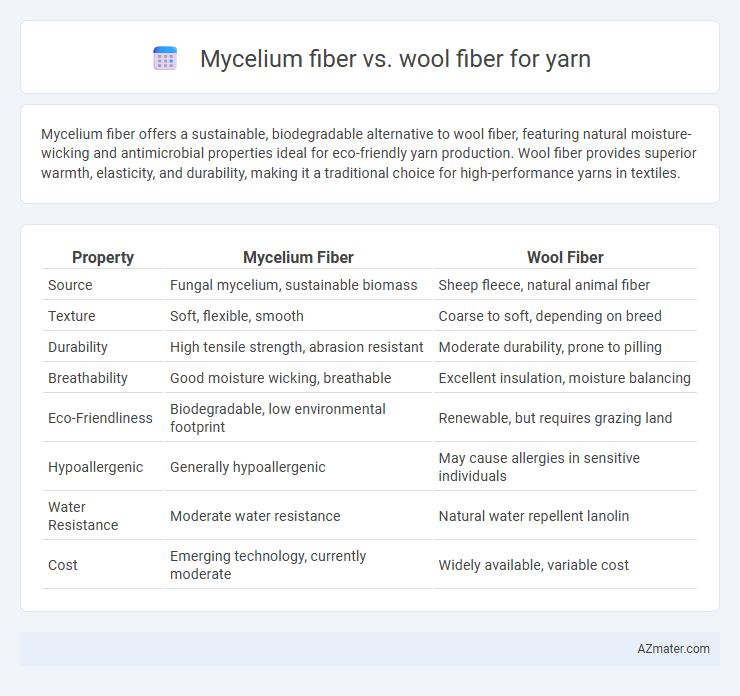Mycelium fiber offers a sustainable, biodegradable alternative to wool fiber, featuring natural moisture-wicking and antimicrobial properties ideal for eco-friendly yarn production. Wool fiber provides superior warmth, elasticity, and durability, making it a traditional choice for high-performance yarns in textiles.
Table of Comparison
| Property | Mycelium Fiber | Wool Fiber |
|---|---|---|
| Source | Fungal mycelium, sustainable biomass | Sheep fleece, natural animal fiber |
| Texture | Soft, flexible, smooth | Coarse to soft, depending on breed |
| Durability | High tensile strength, abrasion resistant | Moderate durability, prone to pilling |
| Breathability | Good moisture wicking, breathable | Excellent insulation, moisture balancing |
| Eco-Friendliness | Biodegradable, low environmental footprint | Renewable, but requires grazing land |
| Hypoallergenic | Generally hypoallergenic | May cause allergies in sensitive individuals |
| Water Resistance | Moderate water resistance | Natural water repellent lanolin |
| Cost | Emerging technology, currently moderate | Widely available, variable cost |
Introduction to Mycelium and Wool Fibers
Mycelium fiber, derived from the root-like structures of fungi, offers a sustainable and biodegradable alternative to traditional fibers in yarn production. Wool fiber, sourced from sheep, is valued for its natural warmth, elasticity, and moisture-wicking properties, making it a classic choice in textiles. Both fibers present unique characteristics: mycelium's rapid renewability contrasts with wool's time-tested durability and comfort.
Origins and Production Processes
Mycelium fiber is derived from the root structure of fungi, using a process that cultivates fungal mycelium into a sustainable, biodegradable material through controlled growth on organic substrates. Wool fiber originates from the fleece of sheep, involving animal husbandry, shearing, and extensive cleaning, carding, and spinning processes to create yarn. The mycelium fiber production is eco-friendly and rapidly renewable, while wool harvesting depends on livestock management and traditional textile practices.
Sustainability and Environmental Impact
Mycelium fiber, derived from fungal mycelium, presents a highly sustainable alternative to traditional wool fiber due to its rapid growth rate and low resource requirements, including minimal water and land use. Unlike wool, which involves animal farming with significant methane emissions and land degradation, mycelium fiber production generates considerably lower greenhouse gases and biodegrades naturally without chemical treatments. The adoption of mycelium fiber in yarn manufacturing supports circular economy principles by utilizing agricultural waste substrates and reducing reliance on animal agriculture, thus mitigating environmental impact.
Physical Properties and Texture
Mycelium fiber offers lightweight, flexible, and breathable characteristics with a smooth, leather-like texture, making it an innovative alternative to traditional fibers. Wool fiber is known for its natural elasticity, excellent insulation, moisture-wicking ability, and a soft to coarse texture depending on the breed and processing method. Both fibers provide durability, but mycelium's sustainable and biodegradable properties create unique applications in eco-friendly yarn production.
Durability and Longevity
Mycelium fiber offers remarkable durability due to its natural resistance to moisture, mold, and bacteria, extending the lifespan of yarn products significantly compared to traditional wool fiber. Wool fiber, while renowned for its elasticity and warmth, tends to be more susceptible to wear and degradation over time, especially when exposed to frequent washing and friction. Advances in mycelium technology enhance tensile strength and abrasion resistance, making it a sustainable and long-lasting alternative to conventional wool yarn.
Dyeing and Color Retention
Mycelium fiber exhibits superior dye absorption due to its porous structure, allowing vibrant and long-lasting colors compared to wool fiber, which can sometimes fade faster due to its natural lanolin content interfering with dye adherence. The protein-based composition of wool tends to hold dye molecules differently, often leading to a softer, more muted palette, while mycelium fiber maintains consistent color intensity even after multiple washes. Moreover, mycelium's eco-friendly and biodegradable properties offer a sustainable alternative for yarn dyeing with enhanced color retention.
Comfort and Allergies
Mycelium fiber offers exceptional breathability and moisture-wicking properties, enhancing comfort during prolonged wear compared to traditional wool fiber. Its hypoallergenic nature reduces the risk of skin irritation and allergic reactions, making it suitable for sensitive skin, whereas wool fiber can trigger allergies due to lanolin content. Mycelium yarn's lightweight and soft texture further contribute to a comfortable, itch-free experience, surpassing wool's sometimes coarse and itchy feel.
Applications in Yarn and Textiles
Mycelium fiber in yarn offers sustainable and biodegradable alternatives to traditional wool, excelling in eco-friendly textile applications such as fashion and upholstery. Wool fiber remains valued for its natural warmth, elasticity, and moisture-wicking properties, ideal for performance clothing and cold-weather fabrics. Mycelium's unique cellular structure enables innovative textures and breathability, making it a promising option for modern, eco-conscious textile products.
Cost and Accessibility
Mycelium fiber offers a cost-effective alternative to traditional wool fiber, with production costs generally lower due to faster growth cycles and less resource-intensive cultivation. Wool fiber, while widely accessible globally through established sheep farming industries, can be expensive due to labor, processing, and seasonal limitations. Mycelium fiber's scalability and potential for sustainable mass production increase its accessibility as demand for eco-friendly yarn alternatives grows.
Future Prospects and Innovations
Mycelium fiber offers sustainable and biodegradable alternatives to traditional wool fibers, leveraging fungal mycelium's rapid growth and minimal environmental impact. Innovations in bioengineering are enhancing mycelium's texture and durability, making it increasingly competitive for yarn production in the fashion and textile industries. Future prospects highlight mycelium's potential to reduce carbon footprints and introduce customizable, eco-friendly yarns with advanced performance characteristics.

Infographic: Mycelium fiber vs Wool fiber for Yarn
 azmater.com
azmater.com